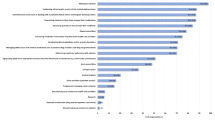Abstract
Objective Health care in the United Kingdom (UK) has undergone a significant change in terms of the range of professionals who are permitted to prescribe medications. This study aimed to capture information on pharmacist prescribing in Northern Ireland (NI). Setting Primary and secondary care in NI. Method A structured self-administered questionnaire was developed and sent to all pharmacists who were identified as qualified prescribers in NI (n = 105), although only 100 respondents provided details of their prescribing status i.e. currently prescribing, previous prescribers and those who had never prescribed. Three versions of the questionnaire were developed to accommodate each category of prescriber. The questionnaire, which sought information on clinical areas/practice settings of prescribers, their working arrangements and barriers to prescribing was distributed by mail on two occasions to maximise response rates. Descriptive analyses were used as appropriate, together with Chi-squared tests or Fisher exact tests to evaluate associations between responses and demographic information, with significance set a priori at P < 0.05. Qualitative data (from the free text response section) were analysed for recurring themes using content analysis. Results A response rate of 76.0% (n = 76) was achieved. There were more female respondents (73.7%) than males (26.3%). Nearly 50% of respondents were currently prescribing (n = 36; 47.4%), 46.1% (n = 35) had never prescribed and 6.6% (n = 5) had prescribed in the past. There were perceived benefits in terms of patient care and perception of the pharmacist within the health care team. A number of barriers to pharmacist prescribing were reported. Independent prescribing was viewed as the way forward, although pharmacists expressed reluctance to prescribe without a diagnosis or beyond the team setting. Conclusion Pharmacy prescribing has yet to fully embedded in routine practice. This study has shown that the number of qualified prescribers in NI is relatively small and not all have taken up prescribing responsibilities. Well recognised barriers were reported as reasons as to why qualified prescribers were unable to use their prescribing skills. Further research should provide an in-depth understanding of pharmacy prescribing in NI and examine patients’ experiences of this form of practice.

Similar content being viewed by others
References
Crown Report: Review of prescribing, supply and administration of medicines. 1999; Final report. London: Department of Health. http://www.dh.gov.uk/dr_consum_dh/groups/dh_digitalassets/@dh/@en/documents/digitalasset/dh_4077153.pdf. Accessed 10 Jan 2010.
Offredy M. Development of non-medical prescribing—Historical background and competency framework for successful prescribing. In: Sodha M, Dhillon S, editors. Non-medical prescribing. London: Pharmaceutical Press; 2009. p. 1–10. ISBN: 9780853697688.
Department of Health. Supplementary prescribing by nurses and pharmacists with the NHS in England: a guide for implementation. March 2003. http://www.dh.gov.uk/dr_consum_dh/groups/dh_digitalassets/@dh/@en/documents/digitalasset/dh_4068431.pdf. Accessed 10 Jan 2010.
Department of Health, Social Services and Public Safety. Supplementary prescribing by nurses and pharmacists within the HPSS in Northern Ireland: a guide for implementation. April 2004. http://www.dhsspsni.gov.uk/prescribing_nurses_pharmacists_in_hpss_ni.pdf. Accessed 4 Feb 2010.
Wingfield J. Legal and ethical aspects of prescribing. In: Sodha M, Dhillon S, editors. Non-medical prescribing. London: Pharmaceutical Press; 2009. p. 12–30. ISBN: 9780853697688.
Department of Health. Improving patients’ access to medicines: a guide to implementing nurse and pharmacist independent prescribing within the NHS in England. April 2006 www.dh.gov.uk/nonmedicalprescribing. Accessed 10 Oct 2010.
Royal Pharmaceutical Society of Great Britain. Outline curriculum for training programmes to prepare pharmacist prescribers. London: Royal Pharmaceutical Society of Great Britain; 2006.
George J, McCaig D, Bond CM, Cunningham ITS, Diack HL, Watson AM, Stewart DC. Supplementary prescribing: early experiences of pharmacists in Great Britain. Ann Pharmacother. 2006;40:1843–50.
Weiss MC, Sutton J, Adams C. Exploring innovation in pharmacy practice: a qualitative evaluation of supplementary prescribing by pharmacists. 2006; Royal Pharmaceutical Society of Great Britain. http://www.pprt.org/Documents/Publications/Exploring_innovation_in_pharmacy_practice_supplementary_prescribing.pdf. Accessed 3 February 2010.
Cooper RJ, Anderson C, Avery T, et al. Nurse and pharmacist supplementary prescribing in the UK-a thematic review of the literature. Health Policy. 2008;85:277–92.
Guillaume L, Cooper R, Avery A, et al. Supplementary prescribing by community and primary care pharmacists: an analysis of PACT data 2004–2006. J Clin Pharm Ther. 2008;33:11–6.
Lloyd F, Hughes CM. Pharmacists’ and mentors’ views on the introduction of pharmacist supplementary prescribing-a qualitative evaluation of views and context. Int J Pharm Pract. 2007;15:31–7.
Lloyd F, Parsons C, Hughes C. ‘It’s showed me the skills that he has’: pharmacists’ and mentors’ views on pharmacist supplementary prescribing. Int J Pharm Pract. 2010;18 (1):29–36.
Stewart D, George J, Pfleger D, et al. Pharmacist supplementary prescribing training: a study of pharmacists’ perceptions and planned participation. Int J Pharm Pract. 2007;15:319–25.
Baqir W, Clemerson J, Smith J. Evaluating pharmacist prescribing across the north east of England. Brit J Clin Pharm. 2010;2:147–9.
Berry D, Courtenay M, Bersellini E. Attitudes towards, and information needs in relation to, supplementary nurse prescribing in the UK: an empirical study. J Clin Nurs. 2006;15:22–8.
O’Neill R. Clinical governance and patient safety in prescribing. In: Sodha M, Dhillon S, editors. Non-medical prescribing. London: Pharmaceutical Press; 2009. p. 32–57. ISBN: 9780853697688.
Offredy M. Clinical decision making and evidence-based prescribing. In: Sodha M, Dhillon S, editors. Non-medical prescribing. London: Pharmaceutical Press; 2009. p. 85–97.
Stewart D, MacLure K, Bond C, et al. Pharmacist prescribing in primary care: the views of nominated patients across Great Britain who had experienced the service. Int J Pharm Pract. 2010; 18 (suppl 2):15–16.
Weiss MC, Sutton J. The changing nature of prescribing: pharmacists as prescribers and challenges to medical dominance. Sociol Health Ill. 2009;31(3):406–21.
Acknowledgments
The authors would like to thank all pharmacist prescribers who completed the questionnaire. A copy of the questionnaire can be made available to the reader on request.
Funding
This work was supported by Health and Social Care Research and Development (HSC R and D) Northern Ireland.
Conflicts of interest
None.
Author information
Authors and Affiliations
Corresponding author
Rights and permissions
About this article
Cite this article
McCann, L., Haughey, S., Parsons, C. et al. Pharmacist prescribing in Northern Ireland: a quantitative assessment. Int J Clin Pharm 33, 824–831 (2011). https://doi.org/10.1007/s11096-011-9545-7
Received:
Accepted:
Published:
Issue Date:
DOI: https://doi.org/10.1007/s11096-011-9545-7




